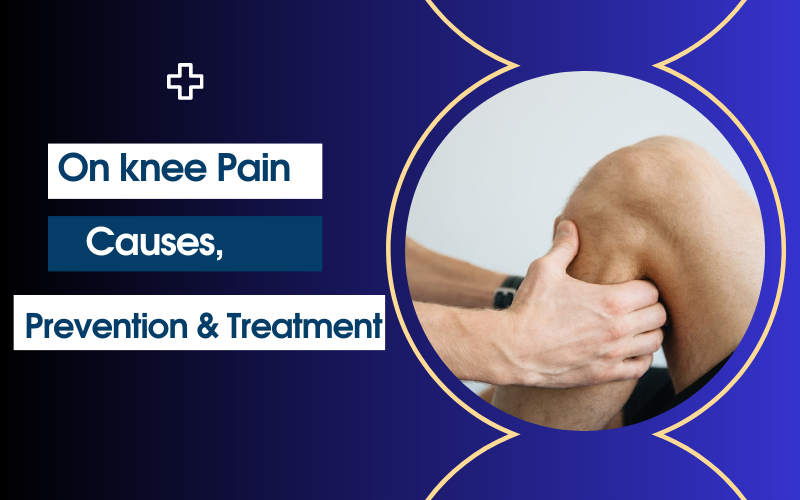What is knee pain
Knee pain is a prevalent issue that impacts individuals across all age groups.. Whether it’s due to injury, overuse, or underlying medical conditions, knee pain can significantly impact daily life and mobility. In this comprehensive guide, we’ll explore the various causes of knee pain, from minor strains to chronic conditions, and discuss effective strategies for managing and alleviating discomfort.
Understanding the Knee:
The knee is among the largest and most intricate joints found in the human body. It is composed of three bones: the femur (thigh bone), the tibia (shin bone), and the patella (kneecap). These bones are connected by ligaments, tendons, and cartilage, which work together to provide stability and facilitate movement.
Causes of knee pain?
- Injuries:
- Sprains and Strains: These occur when ligaments or muscles surrounding the knee are stretched or torn, often due to sudden twisting or impact.
- Torn Meniscus: The meniscus is a rubbery cartilage that cushions the knee joint. A meniscus tear can lead to discomfort, inflammation, and rigidity.
- Anterior Cruciate Ligament (ACL) Injury: A tear or sprain of the ACL, commonly seen in athletes, can result in instability and pain in the knee.
- Patellar Tendinitis: Also known as jumper’s knee, this condition involves inflammation of the patellar tendon, which connects the kneecap to the shinbone.
- Overuse:
- Runner’s Knee: Characterized by pain around or behind the kneecap, runner’s knee often develops from repetitive stress on the knee joint, common in activities like running, cycling, or jumping.
- Iliotibial (IT) Band Syndrome: The IT band, a thick band of tissue running from the hip to the shin, can become inflamed with repetitive use, leading to outer knee pain.
- Medical Conditions:
- Osteoarthritis: A degenerative joint disease, osteoarthritis occurs when the protective cartilage in the knee wears down over time, leading to pain, swelling, and stiffness.
- Rheumatoid Arthritis: An autoimmune disorder, rheumatoid arthritis causes inflammation of the synovial membrane lining the knee joint, resulting in pain and joint damage.
- Gout: Gout is a form of arthritis that occurs due to the accumulation of uric acid crystals in various joints, such as the knee, resulting in abrupt and intense pain.
Managing Knee Pain:
1. Rest and Ice:
- Resting the knee allows injured tissues to heal. Avoid activities that exacerbate pain or strain the knee joint.
- The application of ice packs to the impacted region can assist in decreasing inflammation and easing discomfort. Aim for 15-20 minutes of ice therapy every few hours.
2. Compression and Elevation:
- Compression bandages and knee sleeves are effective in offering support and minimizing swelling.
- Elevating the leg above heart level can help minimize swelling by allowing excess fluid to drain away from the knee.
3. Medications:
- Over-the-counter pain relievers such as acetaminophen, ibuprofen, or naproxen can help alleviate mild to moderate knee pain.
- Topical pain relievers, such as ointments or bandages, have the ability to offer targeted alleviation.
4. Physical Therapy:
- A customized exercise regimen can be created by a physical therapist to enhance the strength of the muscles surrounding the knee, increase flexibility, and improve joint stability.
- Therapeutic modalities such as ultrasound or electrical stimulation may also be used to reduce pain and inflammation.
5. Bracing and Supports:
- Knee braces or supports can provide additional stability and alleviate pressure on the affected area.
- Custom orthotics may be recommended to correct alignment issues that contribute to knee pain.
6. Injections:
- Corticosteroid injections can help reduce inflammation and relieve pain in cases of severe knee pain due to conditions like arthritis.
- Hyaluronic acid injections may be recommended to lubricate the joint and improve mobility, particularly in cases of osteoarthritis.
7. Surgery:
- If conservative treatments prove ineffective in providing relief, surgical intervention may be required in severe cases.
- Procedures such as arthroscopy, meniscus repair, ligament reconstruction, or knee replacement may be performed depending on the underlying condition and severity of damage.
Preventing Knee Pain:
1. Maintain a Healthy Weight:
- Excess weight can increase pressure on the knees, contributing to wear and tear. Maintaining a healthy weight can reduce the risk of developing knee pain.
2. Exercise Smart:
- Incorporate low-impact exercises such as swimming, cycling, or elliptical training to strengthen muscles without putting excessive strain on the knees.
- The application of ice packs to the impacted region can assist in decreasing inflammation and easing discomfort.
3. Use Proper Technique:
- Whether running, jumping, or lifting weights, using proper technique can help prevent knee injuries.
- Ensure proper footwear and equipment are used to support the knees during physical activities.
4. Stay Flexible:
- Stretching exercises can improve flexibility and reduce stiffness in the knee joint. Make sure to include stretching in your daily regimen, particularly prior to and following physical activity.
5. Listen to Your Body:
- Be vigilant for any indications of knee pain or discomfort. If you experience pain, swelling, or instability in the knee, seek medical attention promptly.
Conclusion
Knee pain is a common condition that can have a significant impact on quality of life. By understanding the causes of knee pain and adopting appropriate management strategies, individuals can reduce discomfort, improve mobility, and prevent further injury. From rest and ice therapy to physical therapy and surgical interventions, a multidisciplinary approach is often necessary to effectively address knee pain and restore function. Remember, early intervention and proactive management are key to maintaining healthy, pain-free knees for years to come.




